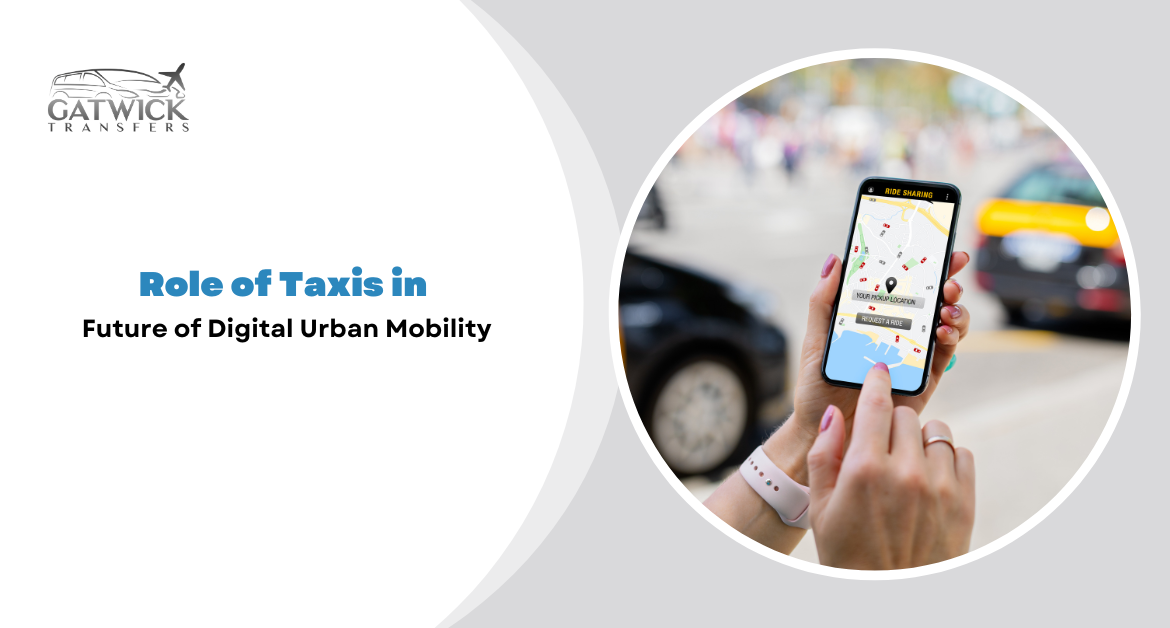The future of urban mobility is undergoing a profound transformation, driven by advances in technology and changing consumer preferences. Taxis, once a staple of urban transportation, are poised to play a pivotal role in this evolving landscape. In this blog post, Gatwick-1 Transfers will explore the pivotal Role of Taxis in the Future of Digital Urban Mobility and how taxis are adapting to the digital age and reshaping the future of urban mobility.
The Current State of Urban Mobility
Urbanization is on the rise, and with it, the challenges associated with congestion, pollution, and limited parking space. Traditional car ownership is giving way to a more diversified array of transportation options, including ride-sharing services, electric scooters, and public transit. These changes are driven by a growing demand for convenience, environmental concerns, and the rise of digital technology.
The Role of Taxis in the Future of Digital Urban Mobility
The Rise of Ride-Hailing Services
The emergence of ride-hailing services like Uber and Gatwick-1 Transfers marked a significant shift in urban transportation. These platforms harnessed the power of smartphones, GPS technology, and digital payments to connect riders with drivers. Taxis found themselves facing stiff competition from these innovative newcomers.
However, instead of succumbing to disruption, traditional taxi companies have been quick to adapt. Many taxi services have launched their own apps, enabling customers to book rides conveniently and compete on a level playing field with ride-hailing giants.
The Role of Autonomous Taxis
The future of digital urban mobility wouldn’t be complete without mentioning autonomous vehicles. Taxis are at the forefront of this technological revolution. Companies like Gatwick-1 Transfers, Iconic Travels, and Uber are investing heavily in self-driving taxis. These vehicles have the potential to significantly reduce the cost of transportation while improving safety and reducing congestion.
Imagine a future where you summon an autonomous taxi with a few taps on your smartphone, and it arrives promptly, taking you to your destination without the need for a human driver. This vision could revolutionize urban mobility, making it more efficient and sustainable.
Integration with Public Transit
Taxis are also finding ways to integrate seamlessly with public transit systems. Many cities are exploring partnerships between taxi companies and public transportation agencies to offer riders a more comprehensive and convenient mobility experience. This approach can bridge the first-mile/last-mile gap, making it easier for people to access public transit options.
Additionally, digital platforms are facilitating multimodal transportation, allowing users to plan and pay for a combination of taxi rides, buses, trains, and even bike-sharing, all in one app. This integration promotes a more sustainable and interconnected urban transportation network.
Environmental Sustainability
As cities grapple with air quality issues and climate change, taxis are adapting to become more environmentally friendly. Electric taxis are becoming increasingly common, reducing emissions and noise pollution in urban areas. Many cities are also incentivizing the adoption of electric taxis through subsidies and charging infrastructure development.
Furthermore, taxi companies are exploring ways to reduce their carbon footprint by optimizing routes and encouraging ride-sharing among passengers, further contributing to a greener future for urban mobility.
Customization and Passenger Experience
The future of taxis in digital urban mobility is not just about the technology under the hood; it’s also about enhancing the passenger experience. Taxis are incorporating features like Wi-Fi, entertainment systems, and advanced booking options to attract and retain customers. Some services are even experimenting with environmentally-friendly and spacious interior designs to make the ride more enjoyable.
Key Trends and Transformations
- Ride-Sharing Platforms: Ride-sharing companies like Uber and Lyft have disrupted the taxi industry by connecting passengers with drivers through smartphone apps. This has made it easier and more convenient for people to access transportation services.
- Electric Taxis: With the growing emphasis on sustainability, electric taxis are becoming more prevalent. Electric taxis reduce emissions and contribute to cleaner urban environments, aligning with the global push for greener transportation options.
- Autonomous Taxis: Self-driving technology is advancing rapidly, and autonomous taxis are on the horizon. These vehicles could potentially reduce costs, increase safety, and improve the efficiency of taxi services.
- Data-Driven Insights: Taxis are now equipped with GPS and data analytics tools, allowing operators to optimize routes, reduce idle time, and improve overall efficiency. This data-driven approach enhances the quality of service.
Challenges and Opportunities
While taxis have a promising future in digital urban mobility, they also face significant challenges:
- Competition: Taxis must compete with ride-sharing services and emerging mobility solutions, requiring them to adapt and innovate continuously.
- Regulation: Regulatory frameworks need to evolve to accommodate new technologies and business models while ensuring passenger safety and fairness in the market.
- Environmental Concerns: Taxis need to further embrace electric and potentially autonomous technologies to align with sustainability goals.
- Customer Expectations: Passengers now expect a seamless and convenient experience through mobile apps, which means taxis need to invest in technology and customer service.
- Infrastructure: The development of charging infrastructure for electric taxis and the integration of autonomous vehicles into urban environments pose logistical challenges.
Conclusion
In Conclusion, Role of Taxis in the Future of Digital Urban Mobility – Taxis are not fading into oblivion in the face of digital disruption; instead, they are evolving to become a crucial component of the future of urban mobility. With innovations like ride-hailing apps, autonomous taxis, environmental sustainability initiatives, and improved passenger experiences, taxis are finding new ways to meet the evolving needs of urban commuters.
The future of digital urban mobility is dynamic, and taxis are demonstrating their resilience and adaptability. As we navigate the road ahead, it’s clear that taxis will continue to play a vital role in shaping the future of how we get from point A to point B in our cities.
FAQs
1. What is the Role of Taxis in the Future of Digital Urban Mobility?
Taxis are expected to play a significant role in the future of digital urban mobility as they adapt to technological advancements. They will continue to provide on-demand transportation services, with increased efficiency, accessibility, & sustainability.
2. How will taxis leverage digital technology for urban mobility?
Taxis will leverage digital technology through mobile apps, GPS navigation, and integrated payment systems. These tools will enhance user experience, improve route optimization, and enable efficient ride-sharing options.
3. Will self-driving taxis be a part of the future of urban mobility?
Yes, self-driving taxis are likely to be a part of the future urban mobility landscape. Autonomous taxi fleets have the potential to increase safety, reduce costs, and provide 24/7 availability.
4. How will taxis contribute to reducing urban congestion?
Taxis can contribute to reducing congestion by promoting ride-sharing, optimizing routes, and integrating with public transit. This can lead to fewer individual vehicles on the road and more efficient transportation.
5. What role will electric taxis play in sustainable urban mobility?
Electric taxis are crucial for sustainable urban mobility. They help reduce emissions, lower air pollution, and contribute to cleaner cities. Governments and cities are increasingly incentivizing the adoption of electric taxis.


Add Your Comment